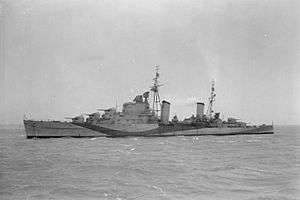HMS Sirius (82)
 Sirius leaving Portsmouth, 17 June 1942 | |
| History | |
|---|---|
| Name: | HMS Sirius |
| Builder: | Portsmouth Dockyard (Portsmouth, UK): Scotts Shipbuilding and Engineering Company (Greenock, Scotland) |
| Laid down: | 6 April 1938 |
| Launched: | 18 September 1940 |
| Commissioned: | 6 May 1942 |
| Decommissioned: | 1949 |
| Out of service: | 14 March 1951 |
| Fate: | Scrapped, Arrived at Blyth yard of Hughes Bolkow, (Northumberland, UK) on 15 October 1956. |
| Notes: | Pennant number 82 |
| General characteristics | |
| Class and type: | Dido-class light cruiser |
| Displacement: |
|
| Length: |
|
| Beam: | 50.5 ft (15.4 m) |
| Draught: | 14 ft (4.3 m) |
| Propulsion: |
|
| Speed: | 32.25 knots (60 km/h) |
| Range: |
|
| Complement: | 480 |
| Armament: |
|
| Armor: |
|
HMS Sirius was a Dido-class light cruiser of the Royal Navy. She was built by Portsmouth Dockyard (Portsmouth, United Kingdom), with the keel being laid down on 6 April 1938. She was launched on 18 September 1940, and commissioned 6 May 1942.
History
Sirius's completion was delayed due to German bombing at Portsmouth Dockyard. She was completed at Scotts Shipbuilding and Engineering Company (Greenock, Scotland). On completion she initially joined the Home Fleet, and was then assigned to operate in the Mediterranean in August for Operation Pedestal. She was then ordered to the South Atlantic to patrol against Axis blockade runners on the Far East route, returning to Gibraltar in November for Operation Torch, the North African landings. As part of Force Q at Bone in December she harried Axis convoys to and from Tunisia until the Axis surrender in North Africa.
Sirius, as part of Force Q, took part in the last naval battle held in the Mediterranean Sea during 1942. Force Q (Comprising cruisers Sirius, Aurora, Argonaut and destroyers Quentin and Quiberon) intercepted a small Axis convoy in the Sicilian Channel destined for Tunisia, starting the Battle of Skerki Bank. The convoy consisted of the German troopship KT-1 (850 GRT) and Italian troopships Aventino (3,794 GRT), Puccini (2,422 GRT) and Aspromonte (a militarized ferry-boat, 976 GRT) and an escort force composed of three destroyers and two torpedo boats. Force Q intercepted the convoy on the night of 1–2 December. The British ships attacked and sank all four troopships alongside one of the escorting destroyers, heavily damaging another and both torpedo boats. The destroyer Camicia Nera launched all of her six torpedoes from a range of only 2 kilometers but missed the British ships. At dawn, the savage short-range engagement saw a clear British victory: Axis losses amounted to 5 ships and over 2000 men, for the loss of HMS Quentin (G78) at dawn to Luftwaffe bombers.[1]
Sirius then formed part of the 12th Cruiser Squadron and participated in the Allied invasion of Sicily, (Operation Husky), in July. For the next few months she supported the army ashore, and in September took part in the occupation of Taranto before transferring to the Adriatic, where, on 7 October 1943 Sirius, Penelope and the destroyers Faulknor and Fury, north of Astipalea (Stampalia) in the Dodecanese, attacked a German convoy consisting of the auxiliary submarine chaser Uj 2111 (former Italian gunboat Tramaglio), the cargo ship Olympus and seven Marinefährprahm, sinking all but one MFP.

On 17 October, Sirius was badly damaged by bombs off Scarpunto, and sailed to Massawa for repairs. These were carried out between November 1943 and February 1944, before the ship returned to Britain for Operation Overlord, the Normandy landings, where she was part of the reserve of the Eastern Task Force. In August she returned to Mediterranean waters for the landings in the south of France, Operation Dragoon. She then served again in the Aegean, where, in October 1944, she was present during the reoccupation of Athens. Sirius remained with the Mediterranean Fleet, 15th Cruiser Squadron, postwar until 1946. After a refit at Portsmouth in 1946, Sirius joined the 2nd Cruiser Squadron with the Home Fleet in March 1947. She was paid off in 1949 and was put up for disposal in 1956. On 15 October 1956 Sirius arrived at the Blyth yard of Hughes Bolkow for breaking up.
References
- ↑ Sgarlato, Nico: Lo scontro del banco di Skerki, Eserciti nella Storia magazine, Delta editions, Parma, gen-feb-2012, p.23-25
- Colledge, J. J.; Warlow, Ben (2006) [1969]. Ships of the Royal Navy: The Complete Record of all Fighting Ships of the Royal Navy (Rev. ed.). London: Chatham Publishing. ISBN 978-1-86176-281-8. OCLC 67375475.
External links
| Wikimedia Commons has media related to HMS Sirius (82). |